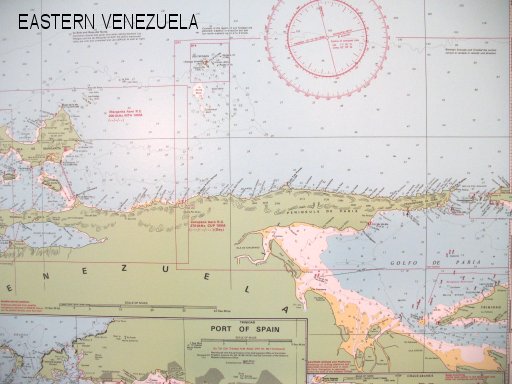
THIS PAGE SHOWS OUR ARRIVAL
TO VENEZUELA IN 2003 AND TAKES YOU TO OUR ARRIVAL TO THE DUTCH
ANTILLES 2006
En route from Trinidad our first arrival
to Venezuela was at the Islands of LosTestigoes. From here we ventured on
to Isla
Margarita at Porlamar before landing on the mainland
Venezuela at Puerto la Cruz
on December 21st 2007. Porlamar and Puerto la Cruz became basically our
home bases during our stay in Venezuela. From Puerto la Cruz
we explored inland Venezuela as well as many of her fantastic
cruising grounds in and around Venezuela including the Golfo de Cariaco and
the Island of
Blanquilla as well as
many other of her offshore islands . Inland we took land trips
around the Golfo de Cariaco,as well as Merida, Angel
Falls, and the Orinoco River a tributary of the Amazon River.
Venezuela was definitely one of the highlights of our time
cruising in the Caribbean. Unfortunately at this time "2018"
we would not recommend a visit to this beautiful country.
This page is rather long to scroll
through. The beginning shows us departing Trinidad to the
Venezuelan Islands of Los Testigoes and then on to Isle de
Margarita.
If you would like to fast track to a
specific area you can click below for your desired destination
Orinoco
River and Angel Falls 2004
Return to
Venezuela from the East Caribbean 2005
Departure to
the Dutch Antilles 2006

December 10, 2003: Arrived Venezuela
A letter Home
Holas Nos Familia Y Amigos,
As we departed Scotland Bay, Trinidad about 600 pm last eve, the
howler monkeys were in full swing. They sound much like lions
roaring. What a send off. Our full moon downwind run has brought
us to a tiny group of islands 92 miles NW of Trinidad. They are
the Testigoes which means disciples. Fifteen
hours of rock and roll under jib alone was plenty and we were glad
to check into Venezuelan customs at Isla Iguana. Only 160
inhabitants live here and survive on fishing. We are loaded with
sugar and flour of which they are in short supply. Amazingly
enough there are seven boats in the anchorage tonight. We have had
our first snorkel and swim. The water is very nutrient rich owing
to discharge from the Orinoco River some 40 plus miles away.
Tomorrow the coastaguardia said they would pay us a visit. The
nice young man who checked us in gave us a warm welcome
-bienvenudo- complete with lots of loud Spanish music. He spoke
English quite well and we tried out some of our amateurish Spanish
on him. It was great fun. Tonight we're anchored behind a small
island and reef with the wind filtering through to provide enough
air for the wind generator.
All is well.
Love to all. bk
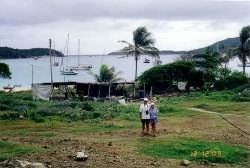
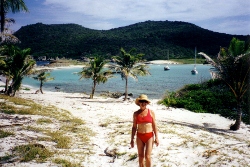
En route to Venezuela Arrival at Los Testigos
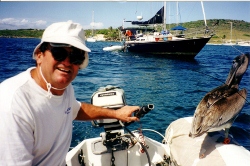 Exploration was
on the agenda for yesterday. Testigo Grande is
almost 2 miles long and a half mile wide with an 800 ft elevation.
Sand dunes on the windward side are spectacular and covered in
shells. Yvonne and I had great fun searching through them. Sand
fleas drove us back to the boats promptly on the lee side.
Bird life here is exceptional. One sociable pelican rode around on
our dinghy with us. This is a nesting ground for frigate, booby,
and pelican. One male frigate was showing his brilliant red mating
colour. How neat to see.Today we rallied before the sun in Los
Testigos and hauled anchors at first light.
Exploration was
on the agenda for yesterday. Testigo Grande is
almost 2 miles long and a half mile wide with an 800 ft elevation.
Sand dunes on the windward side are spectacular and covered in
shells. Yvonne and I had great fun searching through them. Sand
fleas drove us back to the boats promptly on the lee side.
Bird life here is exceptional. One sociable pelican rode around on
our dinghy with us. This is a nesting ground for frigate, booby,
and pelican. One male frigate was showing his brilliant red mating
colour. How neat to see.Today we rallied before the sun in Los
Testigos and hauled anchors at first light.
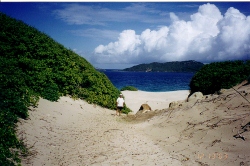
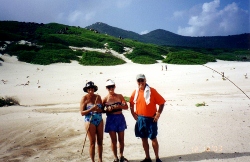
Isla Margarita Dec 14th 2003
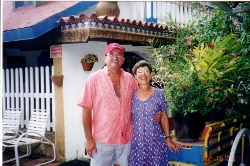 In company with
2 other Canadian sailboats, Mystic Jade and Morning Light, and, of
course, Scrammin' we sailed the 50 nautical miles in tandem to Isla
Margarita. We could hear the fishermen commenting re
our little armada. Quatro veleros, etc. So far we've had very
pleasant reception and lots of friendly waves. Tomorrow we'll
venture ashore to do an international check in. Meanwhile we'll
enjoy the music and merriment ashore, from afar. Porlamar is a
resort city with many high rise hotels and great numbers of
people.
In company with
2 other Canadian sailboats, Mystic Jade and Morning Light, and, of
course, Scrammin' we sailed the 50 nautical miles in tandem to Isla
Margarita. We could hear the fishermen commenting re
our little armada. Quatro veleros, etc. So far we've had very
pleasant reception and lots of friendly waves. Tomorrow we'll
venture ashore to do an international check in. Meanwhile we'll
enjoy the music and merriment ashore, from afar. Porlamar is a
resort city with many high rise hotels and great numbers of
people.
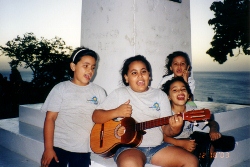
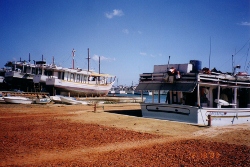
Porlamar: December 21st 2007
A Letter Home
Tundra is resting quite nicely in the anchorage here in Porlamar.
When the wind gets up we all have a tendency to roll a little.
Brian has rigged a bridal so we don't rock and roll as much as
before.
Our check in was smooth as could be with Juan doing the paper work
for us. He is a charming Venezuelan who oversees his business and
provides a guarded dinghy dock service for we yachties. We really
appreciate his assistance. He organizes grocery shopping by bus
and is ready to assist in most matters. Our money is exchanged at
2400 bolivars for one US dollar at his establishment. His
orientation included tips such as: use taxis- don't walk. They are
extremely inexpensive and safe. Stay out of the mangrove areas.
Banditos abound. Keep your diesel tanks topped up and be ready to
sail. The political climate is volatile to say the least.The
general population are warm, kind, and helpful, but they're
extremely poor. The drinking water is piped underwater to the
island. We heard that an Air Canada Charter flight arrived last
week , so maybe things are looking up. A tour of the island with
Carlos of Top Banana Tours was most interesting. He introduced us
to empanadas, arepas, wonderful fruit drinks and more.
The vegetables and fruit are delicious and plentiful. History dates back to Spanish 1500s. Several forts made of mud have survived well. Churches, mostly Catholic, are magnificent with lavish Virgin costumes displayed. Beaches are plentiful and pristine.An Xmas light tour with dinner was amazing. One high light was a crčche constructed totally of banana leaves. Party goers from the mainland of Venezuela are here for the weekend so we are having a quiet day aboard. The mainland is quite visible with the mountains stretching into clear blue skies. It's only a matter of 70 miles away. The eight of us have become a close knit group and are planning Xmas together. Xmas eve is the big celebration here. We plan to eat at a seafood restaurant only minutes from the dock and Xmas day we'll cook our own potluck fare. Mystic Jade is preparing a turkey breast and we have a lovely looking pork roast stuffed with seafood. We'll all go ashore and use Juan's facilities. We did hear of Saddam Hussein and are busy studying espaniol.Via con dios y prospero ano.
Isla
Blanquilla: January 6, 2004
Christmas was noisy and busy in Porlamar. The Venezuelans love fireworks and music and both abounded on shore. Margarita is holiday land for the mainlanders. An Xmas light tour of the east coast, Juangriego and Pampatar with Carlos was delightful. Many embellished crčche scenes were points of focus. My favourite was made totally of banana leaves. Dinner of chateaubriand for two was 19000 bolivars and delicious. We've heard that the legal bolivar rate is up to 1900 and our normal rate of exchange with reliable sources such as Juan is 2400 to 3000 now. We are told that only 3% of the population own the wealth and Chavez is supported by Cuba's Castro, so there is not likely to be any change soon. The local population is desperate for US dollars. After Xmas we all provisioned for a lengthy stay in the out island of Blanquilla, 60 miles northwest of Margarita. From Porlamar we moved around to Juangriego on the west coast for a day, one more go at their delightful cuisine, then off to Blanquilla.
It was an 11 hour trip for us on the 29th of December 2004 with frequent squalls en route. Arrival at Trece Playa Bay around 1600 gave us just enough light to anchor amongst the coral patches before the sunset. Our weather window closed quickly and we have all done a little 'rock and roll' with heavy northeasters and swells nipping at us. Spirits are not to be dampened.
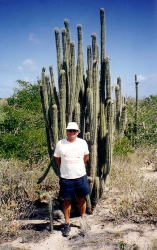 Blanquilla is a desert isle
with miles of cactus, caracara birds (eagle like), green parrots,
and a species of burro which exists only here, was brought over in
1492 by guess who, and number 300 today. Shoreside gatherings and
cookouts have been great fun. New Years Day was another great
adventure. A short walk to the coastguard station was a delight.
The commandant, Jose, welcomed us and invited us for delicious
sopa for lunch. He and his coastguard contingent of 16 to 28 year
olds, man the post for Venezuela.
Blanquilla is a desert isle
with miles of cactus, caracara birds (eagle like), green parrots,
and a species of burro which exists only here, was brought over in
1492 by guess who, and number 300 today. Shoreside gatherings and
cookouts have been great fun. New Years Day was another great
adventure. A short walk to the coastguard station was a delight.
The commandant, Jose, welcomed us and invited us for delicious
sopa for lunch. He and his coastguard contingent of 16 to 28 year
olds, man the post for Venezuela.
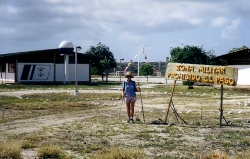
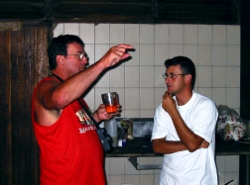
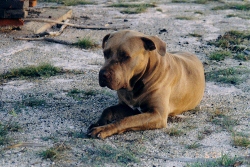
The flotila from Margarita were all anchored on West Beach which gave us good protection from the prevailing easterlies. A few photos follow showing the good time we all had together as the Borochos met each afternoon for Happy Hour
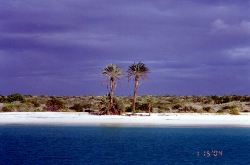
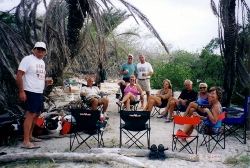
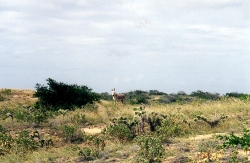
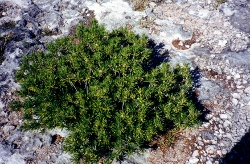
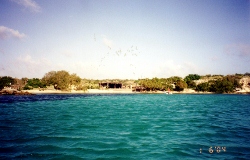 Sunrise, from Texas is a
welcome addition to the flotilla with lots of experience. Their
fridge broke down so we're all storing a little for them. Susan
and Bob hosted a great cocktail party with all that would spoil.
We've netted some good recipes.On the 5th of January we hauled
anchor with Sunrise and moved over to the fishing village. It's
still rolling, but we are collecting water with each passing
squall. Dinghied down to Guardacosta and Jose invited us to anchor
in their lagoon. Manana.
Sunrise, from Texas is a
welcome addition to the flotilla with lots of experience. Their
fridge broke down so we're all storing a little for them. Susan
and Bob hosted a great cocktail party with all that would spoil.
We've netted some good recipes.On the 5th of January we hauled
anchor with Sunrise and moved over to the fishing village. It's
still rolling, but we are collecting water with each passing
squall. Dinghied down to Guardacosta and Jose invited us to anchor
in their lagoon. Manana.
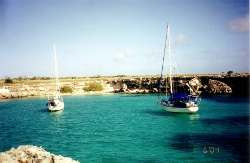 Today,
January 6, 2004, we
anchored at the station and snorkeled the surrounding reefs. What
a peaceful place. My pizza was a great hit with the young men and
we exchanged espanol for anglais for four straight hours. Tomorrow
we will play bocce ball and watch the full moon rise. Life is
wonderful and we feel so fortunate to have met such kind and
generous folk.
Today,
January 6, 2004, we
anchored at the station and snorkeled the surrounding reefs. What
a peaceful place. My pizza was a great hit with the young men and
we exchanged espanol for anglais for four straight hours. Tomorrow
we will play bocce ball and watch the full moon rise. Life is
wonderful and we feel so fortunate to have met such kind and
generous folk.

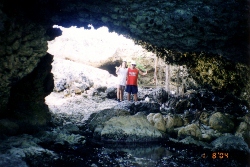
Our visit to Blanquilla was fabulous. Jose showed us the huge caverns along the shoreline filled with fossilized shells. The island is of volcanic origin, so all the coral reef heaved upwards in the 1500's.
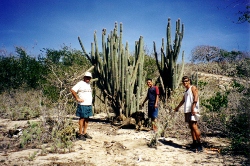 Another tour was to
the donkey boneyard. Apparently this breed of donkey all respect a
certain spot for death rites. It was eerie, but amazing. Lots of
archaeological significance evident.
Another tour was to
the donkey boneyard. Apparently this breed of donkey all respect a
certain spot for death rites. It was eerie, but amazing. Lots of
archaeological significance evident.
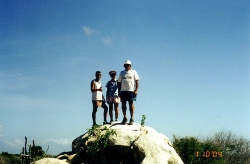 Another interesting
area was a seismology study rock. Jose said it is claimed to
radiate positive energy so we all climbed up on it and breathed
deeply. Great fun. A functional airstrip is used for emergency
purposes and importing military and guests. It was indeed hard to
leave such wonderful hospitality.
Another interesting
area was a seismology study rock. Jose said it is claimed to
radiate positive energy so we all climbed up on it and breathed
deeply. Great fun. A functional airstrip is used for emergency
purposes and importing military and guests. It was indeed hard to
leave such wonderful hospitality.
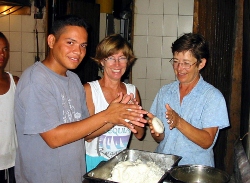 Anthony, the cook, had us
in for a lesson on how to prepare and cook arepas.Susan and I had
a great time trying to perfect Anthony's skill shaping the dough,
taking notes and all enjoyed the results. With weather settling
Sunrise sailed for Magarita to fix her refrigeration.Bocce ball
was a big hit, too. I translated the directions into espanol and
it is so great to observe our learning techniques in reflection.
Studying the words and hearing them in context is pretty exciting.
The pronunciation is quite a different matter. :-) Our
stay at the station was a real treat for us as well as an
immersion course. Lots of study! We took our dictionaries
everywhere. Brian has a small computer-like translator that was a
big hit with the boys. They have few resources.
Anthony, the cook, had us
in for a lesson on how to prepare and cook arepas.Susan and I had
a great time trying to perfect Anthony's skill shaping the dough,
taking notes and all enjoyed the results. With weather settling
Sunrise sailed for Magarita to fix her refrigeration.Bocce ball
was a big hit, too. I translated the directions into espanol and
it is so great to observe our learning techniques in reflection.
Studying the words and hearing them in context is pretty exciting.
The pronunciation is quite a different matter. :-) Our
stay at the station was a real treat for us as well as an
immersion course. Lots of study! We took our dictionaries
everywhere. Brian has a small computer-like translator that was a
big hit with the boys. They have few resources.
On January 12th 2004 with the
north swells dissipating, we sailed around to the west coast of
Blanquilla to Playa Yaque. Here we rejoined our sailing contingent
from Canada and Scrammin'. They were anxious to sail for
provisions and fuel, but Brian still had a cold. We stayed on a
few more days in company with Stormbird from Britain, Watercress
from South Africa and Kairos from Hungary. The morning that our
contingent sailed, Ed from Kairos arrived with bad news. His
starter motor was broken and thence he was without an engine.
Brian and he, Jack and Terry all worked on the motor with parts
from this boat and that, and managed to rebuild it successfully 3
days later. Whew! We all gave a chorus of hooray when we heard the
'music' of his engine again.During this time the fishermen were
coming back from holidays on the mainland and Margarita. One
evening we traded sugar, lunch, hats, hose clamps, motor fittings
and much more for two lobster. Kairos and ourselves roasted them
over the open fire on the beach. Delicious. Next eve, all came to
the fire and Noni on Watercress cooked up a tasty corn beef
omelet. Pat and Jack made wonderful meat shish kabobs. Home early
with a lovely fishing pinero anchored only 20 feet off of Tundra.
The fishermen are our friends everywhere here.
Goodbyes around and we sailed for Robelad at the west end of Margarita in the wee hours, 0300 hours. The moon was bright so we could see close vessels. Radar is very comforting here as there are so many boats out fishing all night. Kairos sailed southwest to Tortuga so we hailed each other until out of range. Once the sun came up I rigged up my trusty fishing rod and lo and behold , didn't we catch a lovely dorado i.e. dolphin fish. Not the mammal. It was terribly exciting and our first since entering the Caribbean. Needless to say we had fish for lunch.
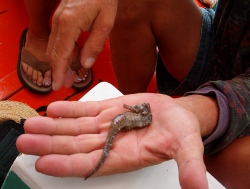 Deliscioso.Robelad was a
shallow, rolly anchorage, so we moved on bright and early to Boca
del Rio. Northerly swells were back so the protection
on the south side was wonderful in spite of noseums and
mosquitoes. We are thankful for our screening. (training
grounds-north channel of Canada!) Next am we ventured into this
little town to meet the locals, practise some more espanol, find
some fresh provisions and enjoy a lunch of scrumptious tuna.
Everyone is delightful. They go out of their way to help us and
giggle at our Spanish attempts. A 'lagoondola' expedition with
Tika was a great treat. He took us through the mangrove swamps to
the north shore. On route we were shown one of our rare sightings
of a sea horse. On the north shore we spent the
afternoon on Playa Restinga with breakers rolling in viciously. We
were glad to have Tundra in a protected harbour. The beach was
literally composed of tiny clam shells i.e. guacucos sporting
exquisite patterns.
Deliscioso.Robelad was a
shallow, rolly anchorage, so we moved on bright and early to Boca
del Rio. Northerly swells were back so the protection
on the south side was wonderful in spite of noseums and
mosquitoes. We are thankful for our screening. (training
grounds-north channel of Canada!) Next am we ventured into this
little town to meet the locals, practise some more espanol, find
some fresh provisions and enjoy a lunch of scrumptious tuna.
Everyone is delightful. They go out of their way to help us and
giggle at our Spanish attempts. A 'lagoondola' expedition with
Tika was a great treat. He took us through the mangrove swamps to
the north shore. On route we were shown one of our rare sightings
of a sea horse. On the north shore we spent the
afternoon on Playa Restinga with breakers rolling in viciously. We
were glad to have Tundra in a protected harbour. The beach was
literally composed of tiny clam shells i.e. guacucos sporting
exquisite patterns.
Radio contact with Scrammin' was successful and they sailed back from Porlamar to meet us in Cubagua. This delightful island produces most of the oyster dinners for Margarita. The 50 or so locals were happy, but extremely needy, with milk at the top of the list. Many young children abound. We gave them all we had and told them we'd pass on their needs to other cruisers going that way. Brian and I fell in love with a wonderful dog there, named him Pal and wished we could take him with us. The shelling on these islands is incredible. Walking across this tiny little island, we explored ruins and shelled, attempting to avoid the scorching sun. A huge dry salina covered the core area.
Brian and I will certainly drag our feet when we decide to move on. . But on we moved for the long one day sail to Margarita and a few days later after completing our circumnavigation of Margarita we were again resting quietly on a bridal at Porlamar. Again we're back to reprovisioning in the busy city of Porlamar. It is an amazing city with such a diverse population. Just off our anchorage is a mangrove swamp with banditos exuding poverty, yet several blocks away there is an extravagant shopping mall with upscale stores from all over the world. Since we left the US dollar has gone up to 2800 bolivars and it is predicted to devalue more. There is apparently going to be a review of the November referendum by the election committee to ascertain if it was legitimate. It is rumoured that more than half of the population voted against Chavez. We'll see.
On the 22nd January 2004, Scrammin' and ourselves arrived back in Porlamar. This completed our first circumnavigation of Margarita. It's been a delightful experience. Tomorrow we plan to meet Liz and Paul Malo at their cruise ship and enjoy a day ashore with them. Midweek we will sail to the Isle of Coche en route to the Golfo de Cariaco for the next few weeks. We will all sail in tandem and keep in close touch.
On the 28th of January we hauled anchors and sailed over to Isla de Coche. Anchoring in front of the old hotel was fine until we discovered that it was closed and dilapidated. Fortunately for us we found a taxi driver who gave us a fine tour of the island and suggested that we move up to the north under a new all inclusive development. This was more comfortable, plus we treated ourselves to lunch and a swim in their lovely fresh water pool. Feeling pretty spoiled we headed back to the boats and watched while the fishermen surrounded us with their bait nets. Yes, we were very secure! Departure for the Golfo was planned for 0300 so we changed our plans and stayed another day. Next evening before they set their nets we moved out a short distance and slept soundly until our early departure.
ARRIVAL
AT THE GOLFO de CARIACO 2004
On February 10th 2004 we anchored at the easternmost end of Golfo de Cariaco alongside Scrammin.What a wonderful night sail downwind to the entrance of the Golfo. Many dolphin and pineros (fishing boats) were there to greet us in the early dawn. Rounding the western tip of the Araya peninsula into the Golfo was a challenge as we pointed our bows east again. Williwaws shriek down the hills and create huge headwinds. Cruising knowledge advises us not to go to Cumana on the south shore unless one plans to stay in a marina. As the first city in South America it has an impressive skyline and very regular commercial sea traffic.
Our first anchorage was at Puerto Real just short of 10 miles into the Golfo on the north shore. It is a fishing village with many dogs, goats and roosters, obviously independent. We screened in against the flies and slept soundly. Fishing shelters along the shoreline and lookouts up higher in the hills are everywhere.
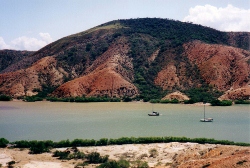 Laguna Grande
is only 4 miles east. This is a spectacular area that is layed out
much like Oak Bay in the North Channel of Canada. We subsequently
coined it our South Channel. The desert topography is eroding
ochre coloured hills full of cacti of every description. The rocks
of quartz, iron and many more are a study in geology. Picturing
this fringed by bright green mangroves at the waters edge is
tricky but the vistas are exceptional. The only inhabitants are a
few fishermen who appear to exist on oysters, conchas (clams and
various shells) and rays, which they trap at the eastern head of
the bay. With Scrammin, we lazed away a week exploring and
relaxing, even polished the stainless. What a treat! Magnificent
frigate birds and pelicans roosted on an island just off our
portsides. They were entertainment plus at dawn and dusk.Below
enjoy a few views as we witnesed as we hiked around Laguna Grande
Laguna Grande
is only 4 miles east. This is a spectacular area that is layed out
much like Oak Bay in the North Channel of Canada. We subsequently
coined it our South Channel. The desert topography is eroding
ochre coloured hills full of cacti of every description. The rocks
of quartz, iron and many more are a study in geology. Picturing
this fringed by bright green mangroves at the waters edge is
tricky but the vistas are exceptional. The only inhabitants are a
few fishermen who appear to exist on oysters, conchas (clams and
various shells) and rays, which they trap at the eastern head of
the bay. With Scrammin, we lazed away a week exploring and
relaxing, even polished the stainless. What a treat! Magnificent
frigate birds and pelicans roosted on an island just off our
portsides. They were entertainment plus at dawn and dusk.Below
enjoy a few views as we witnesed as we hiked around Laguna Grande
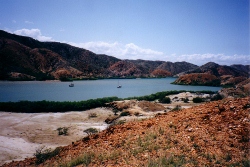
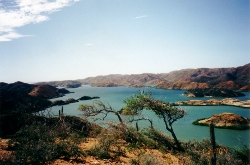

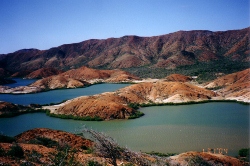
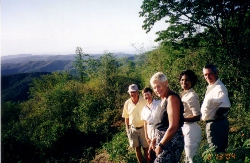 On
February 16th 2004 we moved on to Medregal Village, a resort
area that caters to cruisers. Yolaida and Jean Marc, with their 2
year old daughter, welcomed us royally. Fresh water showers are a
big draw. On Saturday Jean Marc trucked 8 of we cruisers off to
the Cariaco market. Bumpety, bumpety! En route we glimpsed a
caiman and coot in the roadside swamp. Our first. A caiman is a
small crocodile. Very fast. Colourful and friendly describes the
market perfectly. Vegetables and fruits were plentiful. All were
cheerful and happy and helpful. No lemons available, but it was
great fun looking.Sunday we took another day off to swim in their
saltwater pool and enjoy lunch ashore.
On
February 16th 2004 we moved on to Medregal Village, a resort
area that caters to cruisers. Yolaida and Jean Marc, with their 2
year old daughter, welcomed us royally. Fresh water showers are a
big draw. On Saturday Jean Marc trucked 8 of we cruisers off to
the Cariaco market. Bumpety, bumpety! En route we glimpsed a
caiman and coot in the roadside swamp. Our first. A caiman is a
small crocodile. Very fast. Colourful and friendly describes the
market perfectly. Vegetables and fruits were plentiful. All were
cheerful and happy and helpful. No lemons available, but it was
great fun looking.Sunday we took another day off to swim in their
saltwater pool and enjoy lunch ashore.
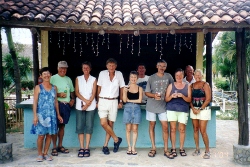
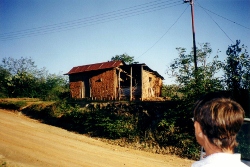
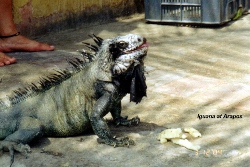
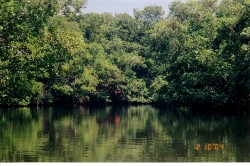 Yesterday, with anchors
hauled once more, we powered into the head of the bay and are
anchored in 12 feet of muddy water admiring the bird life. Several
dinghy expeditions later we have seen scarlet ibis, beautiful
hawks, large white herons, magnificent frigatebirds in mating
prime, pelicans, amazonia kingfishers and more. Quite
spectacular.Tomorrow we return to Medregal Village for a cruisers
potluck lunch organized by Pat and Jim on Lady M 111. The next day
Jean Marc is taking on a tour to the bat caves of Caripe, and then
we'll sail on downwind to Puerto La Cruz sometime next
week.Reading is now on our agenda too, so one can see we are
finally slowing down.Our best wishes to all. We send you brilliant
sunshine. bk
Yesterday, with anchors
hauled once more, we powered into the head of the bay and are
anchored in 12 feet of muddy water admiring the bird life. Several
dinghy expeditions later we have seen scarlet ibis, beautiful
hawks, large white herons, magnificent frigatebirds in mating
prime, pelicans, amazonia kingfishers and more. Quite
spectacular.Tomorrow we return to Medregal Village for a cruisers
potluck lunch organized by Pat and Jim on Lady M 111. The next day
Jean Marc is taking on a tour to the bat caves of Caripe, and then
we'll sail on downwind to Puerto La Cruz sometime next
week.Reading is now on our agenda too, so one can see we are
finally slowing down.Our best wishes to all. We send you brilliant
sunshine. bk
Further adventures in the Gulf de Cariaco
included an all day trip to Carupano located on
the northern coast of Venezuela. Jean Marc brought us home via the
mountainous route. From one summit we could see Carupano to the
northeast, Margarita to the northwest, and the Golfo to the
southwest. It really is spectacular scenery. Carupano was a busy
colourful town with anything you might want. The challenge is to
find it. Kudos to Jean Marc. Another highlight was a day trip to
the Guacharo Caves in Caripe with Jacana (Anne and Johnathon) from
South Africa, Watercress, and Scrammin'. Our bilingual guide took
us a mile into the caves. They were a maze of stalactites and
stalagmites and home to many birds and bats. I was particularly
thrilled to finally see oil birds whom had evaded us at Asa Wright
in Trinidad. They are nocturnal and venture out at nighttime to
eat nearby fruits. In previous centuries their oily body fats were
used to fuel lanterns. A notable statue of Alexander Von Humboldt
purports his scientific study of thermal currents here in earlier
times. Caripe is in the neighbouring state of Monage which is the
second most lucrative state in Venezuela thanks to the oil
industry. Approaching from Sucre state, one of the poorest, one
sees glaring contrast. The roads are beautifully paved with center
line lights and much more. The population are happy and friendly
once one breaks through their initial shyness.
It was difficult to haul anchor at Medregal, but we sailed west on the 17th of February 2004 for Laguna Grande. Here we had another wonderful beach reunion with Morning Light and Mystic Jade before motor sailing for Puerto La Cruz on the 19th. It was a picture perfect day and the scenery is spectacular. Ochre cliffs of Mochima Bay are the first notable sightings west of Golfo de Cariaco, then the Caracas and Chiminas Isles form a delightful passageway on the way to Puerto La Cruz. Jagged rocks and coral shelfs below abound. Fishermen in their pineros were everywhere and many pod of dolphin discombobulated our depth sounder, much to our delight. Fifty miles later we dropped anchor in Chimina Segunda. Brian scraped the prop of barnacles in anticipation of resting in harbour for a length of time.
March
27, 2004: Puerto La Cruz, Venezuela
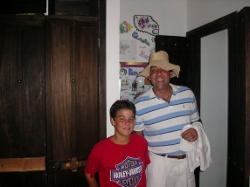 Marnel Quatro (4 in
Spanish) guided us in by VHF until Arnoldo, the dock master, (of
legendary status) guided us into our slip. He handles his dinghy
like a tug and is famous here at Bahia Redonda. We enjoyed a
reunion with Pete and Lani, meeting Roberto, MariElena, and son,
Luis. The latter run our local restaurant in the marina compound.
Here we have three boatyards, many marinas, and a large upscale
shopping mall only a dinghy ride away. Most excursions out of the
marina we do by taxi. The fruit and vegetable market is bustling
and colorful. Meats and fish are available in huge quantities.
Prawns were the best!I have had my broken ear drum diagnosed and
we have discovered our lack of hepatitis A and B immunity.
Apparently our shots in Canada did not take. This is an upscale
community with medical services readily available and
affordable.In early March, Yvonne's sister flew into Caracas. Tom
and Yvonne picked her up amidst a heated political time here, so
we all held our breath until they arrived safely back to the
marina.
Marnel Quatro (4 in
Spanish) guided us in by VHF until Arnoldo, the dock master, (of
legendary status) guided us into our slip. He handles his dinghy
like a tug and is famous here at Bahia Redonda. We enjoyed a
reunion with Pete and Lani, meeting Roberto, MariElena, and son,
Luis. The latter run our local restaurant in the marina compound.
Here we have three boatyards, many marinas, and a large upscale
shopping mall only a dinghy ride away. Most excursions out of the
marina we do by taxi. The fruit and vegetable market is bustling
and colorful. Meats and fish are available in huge quantities.
Prawns were the best!I have had my broken ear drum diagnosed and
we have discovered our lack of hepatitis A and B immunity.
Apparently our shots in Canada did not take. This is an upscale
community with medical services readily available and
affordable.In early March, Yvonne's sister flew into Caracas. Tom
and Yvonne picked her up amidst a heated political time here, so
we all held our breath until they arrived safely back to the
marina.
Off we went cruising to the closer offshore islands with Scrammin' and Mystic Jade. All was wonderful on the beaches and in the water. David on Mystic Jade is a great fire starter and tender so barbecues ashore were fun. Christmas worms of every colour abound in this climate. Dominoes are a favourite afternoon game in the shade. Islas Caracas and Islas Arapos provided comfortable anchorages with ever present fishermen plying their trade. We all enjoyed Mary Joan's company.
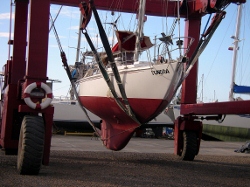 Since the middle of March
we have been to Caracas several times lead on by
Marnel. Tom and Brian and I have just had corrective laser eye
surgery, one week after Marnel. Brian is not wearing glasses at
this point and may have to wear glasses for close vision only. I
have 20 20 vision without glasses, but expect to use reading
glasses eventually, and Tom has had an astigmatism corrected. Wow!
We didn't ever dream our sailing adventures would lead us to this.
We are both in awe.Before our last trip to Caracas we layered our
teak with cetol once more, so now we are recuperating quietly and
planning the next trip. Merida in the Andes will be our next
adventure for some hiking and exploring before our pending haul
out here in Puerto La Cruz.
Since the middle of March
we have been to Caracas several times lead on by
Marnel. Tom and Brian and I have just had corrective laser eye
surgery, one week after Marnel. Brian is not wearing glasses at
this point and may have to wear glasses for close vision only. I
have 20 20 vision without glasses, but expect to use reading
glasses eventually, and Tom has had an astigmatism corrected. Wow!
We didn't ever dream our sailing adventures would lead us to this.
We are both in awe.Before our last trip to Caracas we layered our
teak with cetol once more, so now we are recuperating quietly and
planning the next trip. Merida in the Andes will be our next
adventure for some hiking and exploring before our pending haul
out here in Puerto La Cruz.
We have booked flights home on American Airlines for Wednesday,
the 5th of May
2004 via Caracas, Miami, Detroit.
Sending you warmth and sunshine. bk
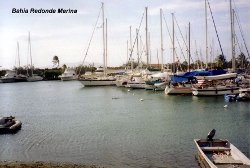
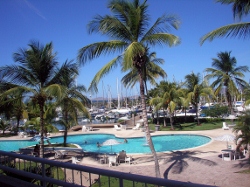
Early April found us cleaning and bagging everything aboard in
preparation for our haulout on April 12th 2004. This
year we are planning to give Tundra a facelift. (This is in
keeping with the human mode in Puerta La Cruz!) As her gelcoat is
sanded down mega dust will be flying. The temperatures were
definitely rising with rainy season impending, so we moved into an
apartment in the marina complex. Air conditioning was much
appreciated for the duration of our stay. Puerto La Cruz is
cradled on the shoreline of Anzoategui state south of Margarita
Island with mountains in the distance.
Mid April, we literally “headed for the hills” with our tour guide Jaime Escribens. Jaime and his delightful friend, Alessandra gave six of us a royal tour of the Andes. Tom and Yvonne of Scrammin’, David and Leanne of Mystic Jade and ourselves plus all of our luggage bounced along in an extended van. Toyota is a big name in Venezuela. Jaime revealed much of the history of Venezuela as we were driven west from Puerta La Cruz through the states of Anzoategui, Miranda, Aragua, Carabobo, Cojedes, Portuguesa, Barinas, and Merida.
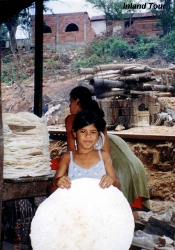 In Miranda our
first stop was at Cupira to view yucca bread in the
making. Yucca is a root vegetable that is peeled (peeling takes on
new meaning when you see one peeling potato-like vegetables with a
3 foot long machete), then ground finely before being mixed with
water and formed into very thin, foot in diameter circles. These
are baked on an open fire. The result is nutritious and keeps
almost indefinitely.
In Miranda our
first stop was at Cupira to view yucca bread in the
making. Yucca is a root vegetable that is peeled (peeling takes on
new meaning when you see one peeling potato-like vegetables with a
3 foot long machete), then ground finely before being mixed with
water and formed into very thin, foot in diameter circles. These
are baked on an open fire. The result is nutritious and keeps
almost indefinitely.
One cannot speak of recent Venezuelan history without mentioning
the hero, Simon Bolivar who liberated the country in the
revolution of 1812. One of his generals of influence was
Miranda, a blanco creole. In 1812 Miranda fought in Velandro. He
had participated in 3 revolutions: the American, French and Latin
American. His Russian wife designed the first flag of Venezuela.
Being a free mason in London, England, he became the first free
mason in Haiti. Well traveled for a man of 1812!
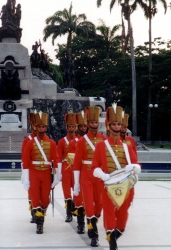
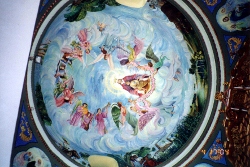 Carabobo became an
independent state in 1821. We were treated to a changing of the
guard ceremony at Campo De Carabobo where very ornate statues
graced Avenue de Paraiso. The uniformed soldiers wore bright red,
similar to those in England.As we left the relatively low terrain
of the coast we approached Portuguesa state. Venezuelans practice
and live in harmony with their religion, mostly catholic. Jaime
took us to several Basilicas.
Carabobo became an
independent state in 1821. We were treated to a changing of the
guard ceremony at Campo De Carabobo where very ornate statues
graced Avenue de Paraiso. The uniformed soldiers wore bright red,
similar to those in England.As we left the relatively low terrain
of the coast we approached Portuguesa state. Venezuelans practice
and live in harmony with their religion, mostly catholic. Jaime
took us to several Basilicas.
The traditional ceiling of the Guanare Bascilica as shown on the right was exceedingly beautiful.
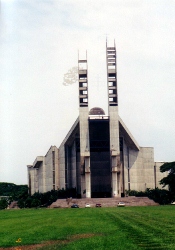 A church reaches basilica
status if a Pope has visited it. The bascilica at Coramoto was
more modern, but huge. Jaime said in the fall, millions of
Venezuelans flock to this church for religious celebrations. Pope
Juan Pablo Segunda visited here. The people were very warm and
kind to we gringos as we visited their attractions
A church reaches basilica
status if a Pope has visited it. The bascilica at Coramoto was
more modern, but huge. Jaime said in the fall, millions of
Venezuelans flock to this church for religious celebrations. Pope
Juan Pablo Segunda visited here. The people were very warm and
kind to we gringos as we visited their attractions
.
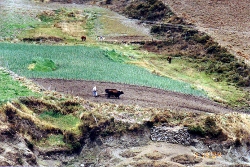
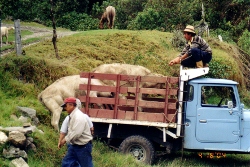 As
we crossed the plains (llanos) Jaime told us of the llaneros
(courageous cowboys) who played a big role in securing the western
areas of Venezuela.The birthplace of Chavez
(president of Venezuela) is in Barina state. It is obvious that
wealth abounds here. Oil, fields of wheat and corn crops, pastures
of cows, great roads were remarkable. In the Chavez regime
extencions (housing developments) have been promoted. Built by
Chinese and Portuguese they are communal dwellings within which
each family has a 200-400 square foot allotment for a house. From
the llanos we drove through wondrous vistas into the mountains.
As
we crossed the plains (llanos) Jaime told us of the llaneros
(courageous cowboys) who played a big role in securing the western
areas of Venezuela.The birthplace of Chavez
(president of Venezuela) is in Barina state. It is obvious that
wealth abounds here. Oil, fields of wheat and corn crops, pastures
of cows, great roads were remarkable. In the Chavez regime
extencions (housing developments) have been promoted. Built by
Chinese and Portuguese they are communal dwellings within which
each family has a 200-400 square foot allotment for a house. From
the llanos we drove through wondrous vistas into the mountains.
Santo Domingo in the state of Merida is
at an elevation of 2704 meters. Here we stayed 2 nights in the
beautiful Hotel Maruco (hand of many stones) built by Maraso Perez
Hemanos. Rain poured down, but nothing could dampen our spirits.
We played dominoes into the wee hours of the morning and enjoyed
our lovely pastoral s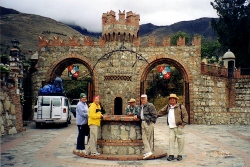 cene with fog clinging to
the trees. Crops grown in this area are potatoes, carrots and
onions. In fact, this is where the potato calls home. Yes,
potatoes were originally shipped to Europe from Venezuela!
Next a m we all invaded Pueblo Jano to shop. All of us bought our
notable yellow (amarillo) rain ponchos and several warm jackets,
Merida toques and mittens that proved invaluable for the rest of
the trip. Tours here included a trout farm-La Casa de la Trucha.
Trout introduced from Canada and thriving wonderfully, we tasted
at the quaint Maraesa Restaurant. A waterfall hike with Jose over
a partly non-existent swing bridge sufficed to wear off any extra
calories consumed at lunch!
cene with fog clinging to
the trees. Crops grown in this area are potatoes, carrots and
onions. In fact, this is where the potato calls home. Yes,
potatoes were originally shipped to Europe from Venezuela!
Next a m we all invaded Pueblo Jano to shop. All of us bought our
notable yellow (amarillo) rain ponchos and several warm jackets,
Merida toques and mittens that proved invaluable for the rest of
the trip. Tours here included a trout farm-La Casa de la Trucha.
Trout introduced from Canada and thriving wonderfully, we tasted
at the quaint Maraesa Restaurant. A waterfall hike with Jose over
a partly non-existent swing bridge sufficed to wear off any extra
calories consumed at lunch!
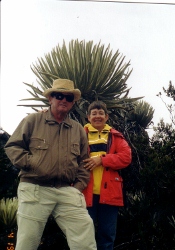 As we approached the Paramos-above
3000 meters- the air thinned and oxygen became noticeably less
available. Yucca like frailijone plants (similar
to lambs ears) grow 1 centimeter a year! There were fields of
them, some taller than us. Jaime cautioned us to walk slowly and
not exert ourselves as we acclimatized to the higher altitude.
As we approached the Paramos-above
3000 meters- the air thinned and oxygen became noticeably less
available. Yucca like frailijone plants (similar
to lambs ears) grow 1 centimeter a year! There were fields of
them, some taller than us. Jaime cautioned us to walk slowly and
not exert ourselves as we acclimatized to the higher altitude.
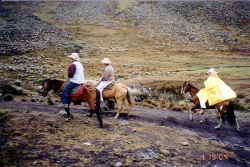 Our
horseback riding afternoon at Laguna Mucubaji (Indian word for
waterlands) was nothing short of enchanting. Ministerio and Paloma
carried Brian and I, ever so gently, up to the ‘cascada’
waterfalls. Beautiful vistas opened up as the fog lifted. Thinking
nothing could be better, we were driven up to the Cirque (glacial
area) at 4700 meters.
Our
horseback riding afternoon at Laguna Mucubaji (Indian word for
waterlands) was nothing short of enchanting. Ministerio and Paloma
carried Brian and I, ever so gently, up to the ‘cascada’
waterfalls. Beautiful vistas opened up as the fog lifted. Thinking
nothing could be better, we were driven up to the Cirque (glacial
area) at 4700 meters.
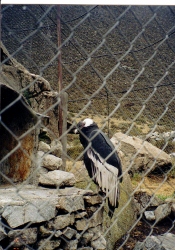 At Pico de Aguila the frailijones
(Condors) were giants. We all donned our mitts and
toques. Farmers plowed their fields of onions, garlic, and
mustard. Eucalyptus trees towered over fields. A visit to see the
magnificent condors was bittersweet. These birds are now kept in
captivity with hopes of a future regenerated population. The
intention is that they will be able to breed and find their
natural home again.
At Pico de Aguila the frailijones
(Condors) were giants. We all donned our mitts and
toques. Farmers plowed their fields of onions, garlic, and
mustard. Eucalyptus trees towered over fields. A visit to see the
magnificent condors was bittersweet. These birds are now kept in
captivity with hopes of a future regenerated population. The
intention is that they will be able to breed and find their
natural home again.
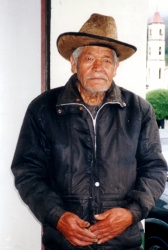 As we descended into
Merida, our trek took us over the Santa Domingo River,
passing through Los Pierdras to the oldest town in the Andes, Boca
Chios. To the left an elder of the village posed for us.
As we descended into
Merida, our trek took us over the Santa Domingo River,
passing through Los Pierdras to the oldest town in the Andes, Boca
Chios. To the left an elder of the village posed for us.
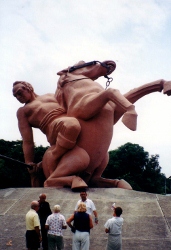 The
town of Mucuchies had a very handsome statue of
Cinjaca-a celebrated guard with his famous Mucuchies dog. Both
died in battle and were much appreciated. A visit to Catalina’s
Mermelada was great fun. After a tour of the owner’s
meticulous operation manufacturing marmalades of unbelievable
numbers of fruits and vegetables, he entertained us in his
tropical gardens.
The
town of Mucuchies had a very handsome statue of
Cinjaca-a celebrated guard with his famous Mucuchies dog. Both
died in battle and were much appreciated. A visit to Catalina’s
Mermelada was great fun. After a tour of the owner’s
meticulous operation manufacturing marmalades of unbelievable
numbers of fruits and vegetables, he entertained us in his
tropical gardens.
ARRIVE MERIDA APRIL 2004
On the 19th of April 2004 we arrived in Merida to stay in a busy part of the city at the Chama Hotel. What a contrast to the lovely mountains. Merida, known as ‘the city within a university’ is located on a steppe between Culata National Park and Sierra Nevada National Park with a population of 500,000. The Andes University graduates students in law, medicine, teachers and attracts students Venezuela wide. There education is free!Jorge, a lawyer, very proudly took us on a walking tour of the inner city and university. Saying goodbye to Jaime we moved into Gioia’s Pasada. Next day we took a bus to Jaji enjoying the magnificent scenery again. This was a very relaxed visit with the citizens. We purchased ponchos native to the area in preparation for our hike in the Andes.
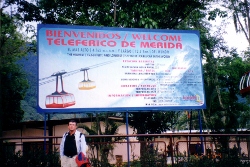
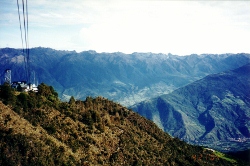 Making
sure to get the first ride to the top on the Teleferico Cable Car
we landed 5 stops later at an elevation of 15,600 feet.
Oxygen was available and the la virgin de la nieve was indeed
standing in snow. Cold it was. Before we left 30 minutes later,
fog drifted around us.
Making
sure to get the first ride to the top on the Teleferico Cable Car
we landed 5 stops later at an elevation of 15,600 feet.
Oxygen was available and the la virgin de la nieve was indeed
standing in snow. Cold it was. Before we left 30 minutes later,
fog drifted around us.
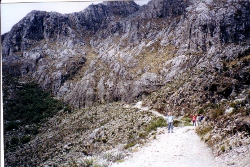
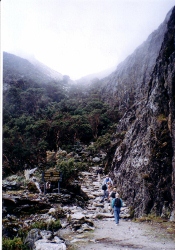 Leaving
from the 3rd stop, we hiked over the main ridge down several
thousand feet into Los Nevados. This arduous 8
and a half hour hike turned into high adventure when some of our
party got lost in the mountains. It was rainy, cold, weather
sporting lightning and thunder. Sr Evio of Los Nevados
saddled his fine horse and took his mules back the trail in search
of our friends of no avail. Citizens of Los Nevados and guests of
our Bella Vista Pasada hiked from door to door looking for them
and tried to console us.
Leaving
from the 3rd stop, we hiked over the main ridge down several
thousand feet into Los Nevados. This arduous 8
and a half hour hike turned into high adventure when some of our
party got lost in the mountains. It was rainy, cold, weather
sporting lightning and thunder. Sr Evio of Los Nevados
saddled his fine horse and took his mules back the trail in search
of our friends of no avail. Citizens of Los Nevados and guests of
our Bella Vista Pasada hiked from door to door looking for them
and tried to console us.
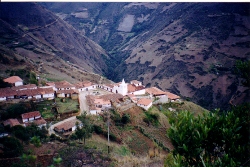
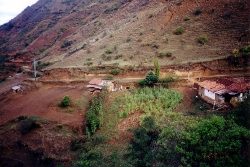
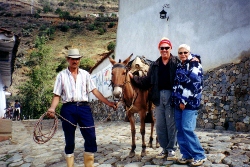
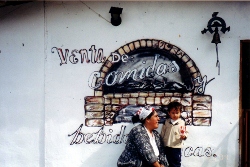
Next morning news arrived, called from the nearest mountain top, (no telephones) that they were safe and had spent the night in a farmers house in good hands. Again Evio went out with his mules and needless to say we had a tearful reunion. This was only part of our great `adventura’! With all reunited we rested out the day in preparation for our 4 by 4 toyota ride out to Merida. Our driver, Encensio, loaded 6 of us, plus three local citizens, plus another riding the rear bumper into his sturdy vehicle. He drove us along a dirt track, with a precipice plunging miles down on one side, for 5+ hours. Frequently he hung his head out the window to make sure his back tire was on the road. Gioia’s pasada, in Merida, was a super welcome sight. Next day Gioia drove us to the airport only to find ourselves fogged in. Another interesting busride ensued west toward Columbia.
Our flight back to Caracas left from La Viaje in bright sunshine. It was a fabulous flight with vistas of the Andes and the famous road running along the coast. This road was built by prisoners in 10 years under the supervision of General Broma.
In Caracas we had our eye check-up. 20-20 vision
is great. We both wear glasses close-up and Brian will go back for
a touch up in November. Busing back to Puerta La Cruz went without
a hitch. After putting finishing touches on Tundra and packing our
gear for Canada we bused back to Caracas. We can recommend the
Parada Pasada near the airport. They provide an excellent early
morning bus service to the airport.
Flights home on American Airline went smoothly and we’re loving Beacon Court and all our shoreside conveniences. We’ll spend the summer renovating our kitchen and gardening. Best wishes to all. If we can provide info for you, give us a call. Best wishes to all.
Hasta luego.
May 23, 2004: Sarnia, Ontario
As we sit comfortably in Sarnia, Ontario witnessing spring
bringing the great outdoors back to life, our last few weeks in
Venezuela seem merely a dream. Thoughts were now to the Canadian
summer and next our next cruise seemed in the distance.
Tundra Travels: Fall 2004 to Spring
2005
Puerto La Cruz., December
26, 2004.
Brian and I had a wonderful summer at home with family and friends. Our lovely daughter and son in law are having our second grandchild in March 2005, so we’ll be home early this year. A happy visit west in October afforded us time to visit all the family including Wilde and her parents. My Dad celebrated 95 years young with a grand party in Oliver.
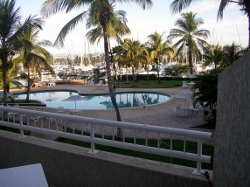 Again
in mid November 2004, we were able to fly south
to Puerto La Cruz, Venezuela. Here we have spent the last month
commissioning Tundra for sailing. She has had a face-lift, a
lovely gelcoat job applied in the Bahia Redonda Marina yard. It
was a lengthy process and all has needed super cleaning and
refitting. While we were at it we refurbished the interior
varnish, finishing just a couple of days before Christmas.
Again
in mid November 2004, we were able to fly south
to Puerto La Cruz, Venezuela. Here we have spent the last month
commissioning Tundra for sailing. She has had a face-lift, a
lovely gelcoat job applied in the Bahia Redonda Marina yard. It
was a lengthy process and all has needed super cleaning and
refitting. While we were at it we refurbished the interior
varnish, finishing just a couple of days before Christmas.
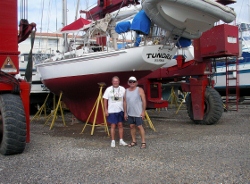
OUR TRIP TO THE ORINOCO
RIVER (A TRIBUTARY OF THE AMAZON RIVER) AND ANGEL FALLS
FOLLOWS
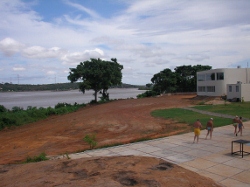 Friends from Sarnia, Joan
and Bob Farrar visited in Nov-Dec 2004. With them, Scrammin’ and
several other yachties we overnighted in Ciudad Bolivar where we
spent a day on the Orinoco river, pirana
fishing, enjoying lunch, and sighting pink, yes pink, dolphins.
Friends from Sarnia, Joan
and Bob Farrar visited in Nov-Dec 2004. With them, Scrammin’ and
several other yachties we overnighted in Ciudad Bolivar where we
spent a day on the Orinoco river, pirana
fishing, enjoying lunch, and sighting pink, yes pink, dolphins.
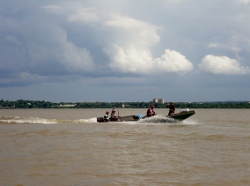
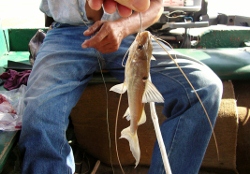
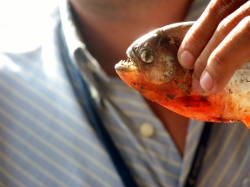
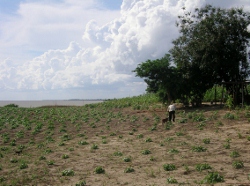
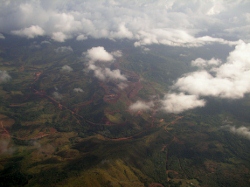
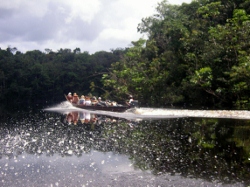 Next day we flew in a
Cessna 607 into Canaima on the Orinoco River Delta for a
dugout canoe adventure to Angel Falls. Being
the highest
Next day we flew in a
Cessna 607 into Canaima on the Orinoco River Delta for a
dugout canoe adventure to Angel Falls. Being
the highest
Our 23 year old guide, Mumbo, of the Kamaracoto indigenous population did a fine job of keeping us all on the right root strewn track. He cooked us a delicious chicken dinner and entertained us with personal anecdotes of his family and friends before tucking us into our hammocks on Isla Raton for our night in the jungle. Our dugout canoe was approximately 40 feet long and was handled masterfully by our driver, oarsmen on the bow, and Mumbo serving lunch. Two short portages and many thrilling rapid shoots rounded out our adventure.
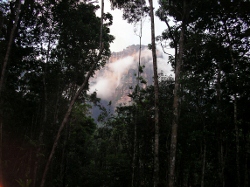
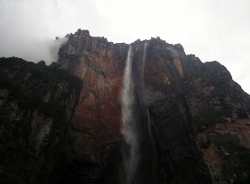
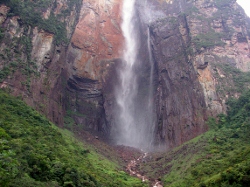
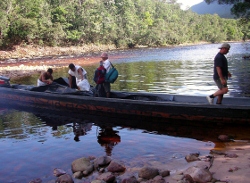
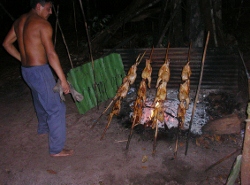
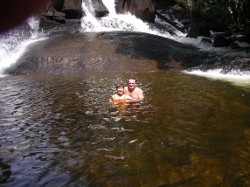
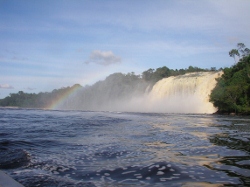
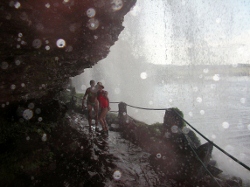 The afternoon
and evening in Canaima afforded us time to have a tour and
“power shower” in the beautiful Sapo Falls.
The afternoon
and evening in Canaima afforded us time to have a tour and
“power shower” in the beautiful Sapo Falls.
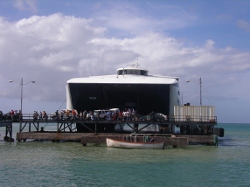
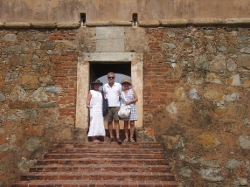 A ferry trip to Margarita
posed real luxury on one of the two rapido Ferries that we
surprisedly found out were built in Australia. The Farrars and
ourselves joined Carlos for one of his Top Banana Tours of the
island. This whirlwind one day circum island tour included
lunch in Juan Griego,a museum visit, some pearl shopping and
many beautiful vistas of east coast pineros.
A ferry trip to Margarita
posed real luxury on one of the two rapido Ferries that we
surprisedly found out were built in Australia. The Farrars and
ourselves joined Carlos for one of his Top Banana Tours of the
island. This whirlwind one day circum island tour included
lunch in Juan Griego,a museum visit, some pearl shopping and
many beautiful vistas of east coast pineros.
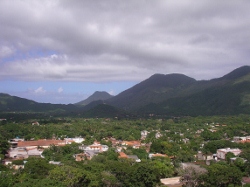
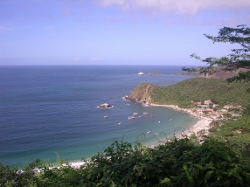
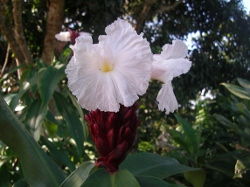
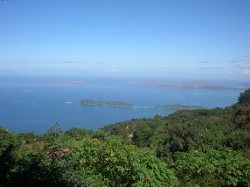 Another
literally cool day was spent in the mountains of Los Altos with
Jose Andreas, visiting the artisanias and having a wonderful
lunch complete with
Another
literally cool day was spent in the mountains of Los Altos with
Jose Andreas, visiting the artisanias and having a wonderful
lunch complete with
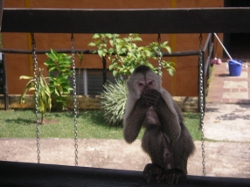
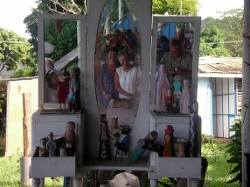
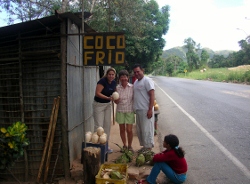
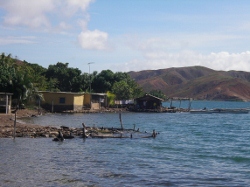
We spent a weekend with Guisepphine and Luis, aged 32 and
34, who drove us all around the Golfo de Cariaco. A pasada in
Araya, sporting another one of the most beautiful beaches in the
world was special treat. Their fishing friends in Merito
welcomed us most warmly to their humble abode. Here they treated
us to a very substantial delisious lunch done on their crude
barbecue The holidays have flown by with lots of entertainment,
including a children’s party for the Barrio children next door.
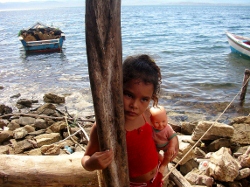
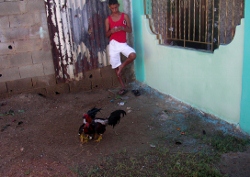
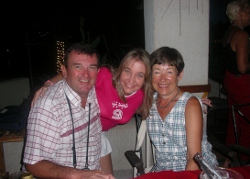 Maria Elena the
proprieter and owner of El Ancla
the restaurant within the marina served us a delightful
Venezuelan meal on Christmas eve and a traditional American
turkey dinner on Christmas day. We feel very fortunate to have
such great friends here. It will be difficult to cast our dock
lines ashore and move on. Hasta leuga for now Amigos.
Maria Elena the
proprieter and owner of El Ancla
the restaurant within the marina served us a delightful
Venezuelan meal on Christmas eve and a traditional American
turkey dinner on Christmas day. We feel very fortunate to have
such great friends here. It will be difficult to cast our dock
lines ashore and move on. Hasta leuga for now Amigos.
While waiting for our Venezuelan cruising permit we
varnished inside and out, installed the dodger and sails. Daniel
cleaned and polished our mast beautifully. Several functions at
Bahia Redonda were very interesting. An SSCA gam on New Year’s
Day focused on the tsunami and how it affected our fellow
sailors and all in Thailand and Phuket. A few very tense days
were spent learning results of the disaster.
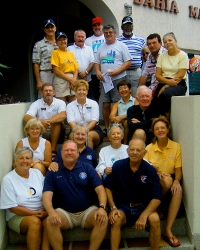 Power
Squadron members of Canada and US met with hopes of founding and
nurturing a Venezuelan Power Squadron. Safe boating, security,
and communications would be some of our interests. A manual has
already been translated into Spanish in Puerto Rico.
Power
Squadron members of Canada and US met with hopes of founding and
nurturing a Venezuelan Power Squadron. Safe boating, security,
and communications would be some of our interests. A manual has
already been translated into Spanish in Puerto Rico.
2005 SAW US BACK IN THE EASTERN
CARIBBEAN AS WE HAD TO LEAVE VENEZUELA IN ORDER TO RETURN FOR
ANOTHER STAY IN VENEZUELA. TO SEE OUR TIME SPENT BACK IN THE
GRENADINES GO TO THE PAGE EASTERN CARIBBEAN to
the year 2005 or click here Return to the East Caribbean 2005
TUNDRA RETURNS TO VENEZUELA on May 24 2005
AFTER DEPARTING FROM THE GRENADINES
LOCATED IN THE EASTERN CARIBBEAN
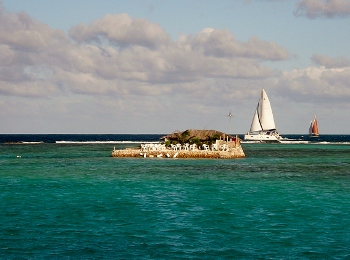 With
Venezuela beckoning and having fulfilled the 45 day “out of
country” requirement for Venezuela, we weighed anchor from
Admiralty Bay, Bequia, heading for our checkout point at Union
Island. Here we enjoyed watching the green
flash at Jose's man made island and cocktail bar that was
contucted with conch
shells.
With
Venezuela beckoning and having fulfilled the 45 day “out of
country” requirement for Venezuela, we weighed anchor from
Admiralty Bay, Bequia, heading for our checkout point at Union
Island. Here we enjoyed watching the green
flash at Jose's man made island and cocktail bar that was
contucted with conch
shells.
Leaving the eastern Caribbean behind, we made
a run downwind from Grenada to the island chain of Los Testigos.
After a overnight rest we sailed in brilliant sunshine to
Margarita. Here we shared a few stories with Stormbird and
Jackobite, met some new folk and renewed old friendships before
sailing off to our destination of Puerta La Cruz.
With the thoughts of our new Grand child in mind we busily
readied Tundra for haul out in the yard at Bahia Redonda Marina
on the 18th of March. She now sits under the balcony of our new
friends, Guissepina and Luis. Their watchful eyes will be
greatly appreciated. Newfound friends, Rhonda and Bruce Holder
from Alberta, kindly hosted us in their apartment for the last
few days so we could comfortably tarp Tundra for the rainy
season on the mainland. Barbecues and seafood sopa mariscoes
were delightful sendoffs.
Flying from Barcelona to Caracas to Miami to
Montreal to Vancouver all went smoothly with Courtney and Greg
welcoming us at the Vancouver Airport. It was so grand to be in
Vancouver in the springtime with the city all abloom. We had a
premium visit with Courtney and Greg, Rod, Titania and Wilde,
before Madison Jean arrived on April 10th.
Our nephew, Michael and wife, Christy, had Tyler
John, the week before Madison, and our niece Kathy has two under
3 1/2 so the Marsh, Coates, Coulthard, Kirby family is expanding
delightfully.
We’re watching spring arrive in Sarnia and all is
growing leaps and bounds. Courtney and Greg will be home in
July. It’s good to see Brian’s Mom well and enjoying her
friends-almost 90! We plan a possible road trip to BC in the
fall, then back to Venezuela in mid-November. Keep in touch.
B&K
On November 21st, 2005 we arrived back to
Puerto La Cruz, Venezuela. Tundra had summered well in
the Bahia Redonda boatyard and we welcomed some 10-degree latitude
warmth as we left behind another Canadian winter. While readying
Tundra for the water we sadly received news of my Mom’s (Margie)
death on Nov 28th. It’s hard to lose my dear sweet Mom. She has
surely done her fair share of suffering and we have a May memorial
service planned for her in Oliver. Tom and Yvonne on Scrammin’
paralleled our progress. Sadly Tom lost his Mom, too. We spent
Xmas together in the marina with other yachtie friends.
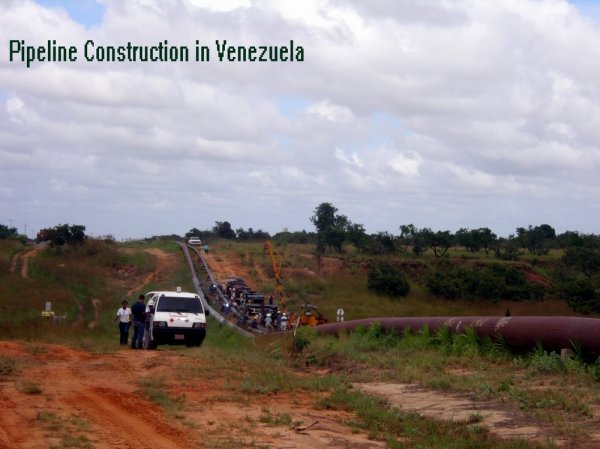 Our Ve friends, Guisse and
Luis, treated us with a visit to El Tigre to see their pipeline
business and home. It was a delightful Ve experience and nice
quiet way to spend my birthday. Being in their company is instant
Spanish immersion for us and wonderful as usual.It took some doing
to install our Icom M 802 single sideband radio. Soldering
delicate pactor junction cables took all of our patience and
several attempts before they were perfect. We are very pleased
with the result and, as you know, our radio systems are a very
important part of our security systems, weather programming and
ship-to-ship communications.
Our Ve friends, Guisse and
Luis, treated us with a visit to El Tigre to see their pipeline
business and home. It was a delightful Ve experience and nice
quiet way to spend my birthday. Being in their company is instant
Spanish immersion for us and wonderful as usual.It took some doing
to install our Icom M 802 single sideband radio. Soldering
delicate pactor junction cables took all of our patience and
several attempts before they were perfect. We are very pleased
with the result and, as you know, our radio systems are a very
important part of our security systems, weather programming and
ship-to-ship communications.
December 28th 2005 found Scrammin and ourselves casting off lines for a cruise into the Golfo de Cariacou. Oculto Bay was our first anchorage and it was a delight to share it with 4 other French cruisers. Safety in numbers is a good rule here now for security reasons. At daybreak Scrammin’ got a surprisingly early start as they had to avoid being netted in by fishermen collecting baitfish. At the entrance to the Golfo sits Cumana, the oldest city in Ve. Here at Cumanagoto Marina, Tom on Morning Light welcomed us to the docks along with Neige, our super helpful, snow-white haired dock assistant. It was holiday time for the locals and the deafening parang and other music didn’t let up until 0600 the next morning! Thus, for more than one reason, we slipped the mooring at first light again to motor up to Medregal Village. By noon we had the anchor down and we’re sitting comfortably having avoided the afternoon trade winds on the nose.
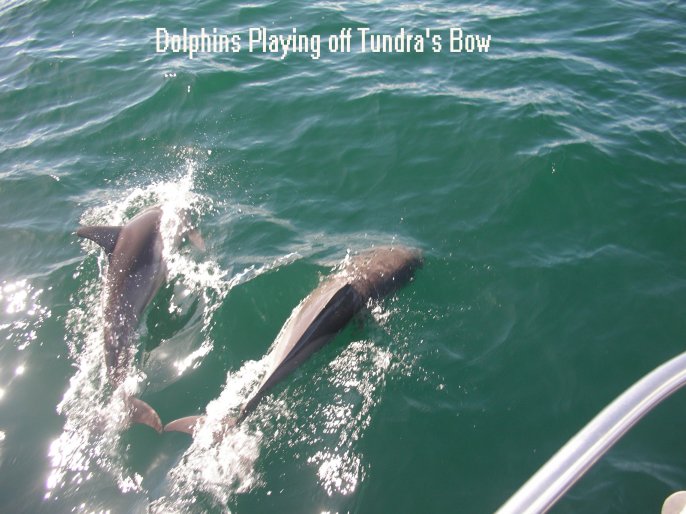 If dolphins are
the measure there must be loads of fish in the Golfo. They played
‘King of the Mountain’ on the keel and kept us entertained all the
way. What beautiful creatures!
If dolphins are
the measure there must be loads of fish in the Golfo. They played
‘King of the Mountain’ on the keel and kept us entertained all the
way. What beautiful creatures!
Jean Marc and Yolaida were lovely hosts once again and we enjoyed several great meals ashore prepared by their new cook, Sergio. The complex is welcoming in that they offer free fresh water showers and invite yachties to swim in their newly tiled fresh water pool. Dominoes in the afternoon by the pool are a nice way to mingle with other yachties. They have a new boatyard in progress and hope to open for haul out business soon.
On the 4th of January 2006 we moved to the end of the Golfo with Scrammin to view the scarlet ibis. They maintain their vivid colour by feasting on shrimp. Dinghy exploration here is a must. Our hardworking fishermen sold us small chub early in the morning and along with the fish came an ample supply of flies and noseums. Screens are a must in the Golfo. We retraced our steps a short hour and a half to Medregal, settled our bills ashore and enjoyed another peaceful sleep. Moving west again, Punta Congrejo was a perfect lunch stop. The flies descended again, but the snorkeling was a treat. Christmas worms abound in brilliant colours. They whip closed at the sight of your finger and are a delight to see. The holding was questionable so we ran another few miles into Laguna Grande. While anchoring here, people were waving on shore for help. They had returned from a shore side hike to their missing dinghy. It had been stolen, moved a few hundred feet away and tucked into the mangroves. Banditos had deflated it, removed all the engine parts they could and departed. A team effort secured the yachties and dingy back on their boat. Within an hour a Pinero of young Ve powered by looking for the rest of their bounty. Needless to say we didn’t sleep well for a couple of nights. Everything is locked on and secured before we retire. Concerned Ve advise us to lock ourselves in and be vigilant when anchoring. Unfortunately it’s a necessity here
.
On January 8th 2006 we said goodbye to Scrammin
who were en route back to Puerta La Cruz and anchored in Laguna
Chica with Caliente, and fun loving Ve on Cisne. This harbour is
home to an active boat building community with strong ties to
mainland Cumana. Early next morning the marooned Gaviota fishing
fleet powered up and departed for another fishing season. January
9th marks the end of their Xmas festivities and it was back to
work for the New Year. Cumanagoto Marina was our next stop.
Thankfully the blaring music had stopped. It was fun to haul out
the sewing machine, spruce up several covers and just enjoy
creating for a few days. As anything new is a temptation here it
is wise to cover your dinghy engine, too. Fresh water on the dock
is a lovely treat so we washed and scrubbed to our hearts content.
Shore side always is an adventure. Brian and I rode the local
busses with the lovely Ve people looking out for our stops all the
way. Lots of chuckling! On the 13th we slipped away at first light
rounding the Araya peninsula for Margarita. It was quite a slug
upwind and up current. Both of us were more than pleased to anchor
at Isla Coche overnight en route. It was a pleasant moonlit night
and we were nestled in amongst a group of German vessels. Coche is
home to a lovely German resort and an avid para sailing community.
Apparently they host world championships yearly.
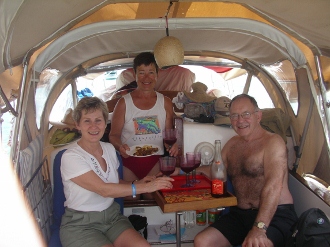
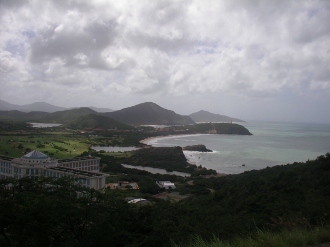 Arrival in
Margarita on the 14th gave us time to search out Margarita Village
and schmooze with the local community of yachties before my
brother Johnny and Marcia arrived on the 18th for 2 weeks ashore.
Unfortunately lots of rain and wind invaded their holiday.
Consequently we toured ashore, enjoyed dominoes at their lovely
accommodation and with the cruisers on Sundays, and shared some
good reads. Brian and I enjoyed fresh water swims and lunching at
the Village with Johnny and Marcia very much. Being duty free, the
island is a mecca for shopping of any kind with pearls being a
special feature.
Arrival in
Margarita on the 14th gave us time to search out Margarita Village
and schmooze with the local community of yachties before my
brother Johnny and Marcia arrived on the 18th for 2 weeks ashore.
Unfortunately lots of rain and wind invaded their holiday.
Consequently we toured ashore, enjoyed dominoes at their lovely
accommodation and with the cruisers on Sundays, and shared some
good reads. Brian and I enjoyed fresh water swims and lunching at
the Village with Johnny and Marcia very much. Being duty free, the
island is a mecca for shopping of any kind with pearls being a
special feature.
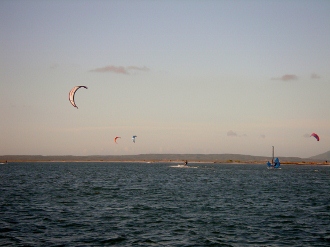
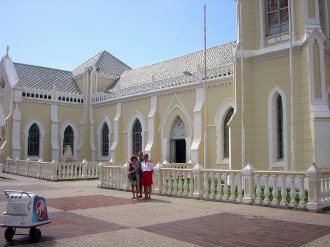 Dining ashore is fun but
it has drawbacks as well and our tummies suffered periodically
trying to adjust to different bacteria. During our 2 weeks
together we managed an overnight trip to Coche. Time disappeared
too quickly as it does when you’re having fun. Home in Margarita
is in the anchorage in front of Marina Juan. Juan is an
enterprising man who provides as many services as he can. A bus
trip to Sigo’s (one of the grocery stores) is arranged Mon, Wed,
and Fri at the moment. He provides a laundry service, internet and
fax. A pinero comes around with diesel and water and can be
contacted at Juan’s. Jack’s restaurant is closed until further
notice. Don’s water baby sank so he is no longer providing water
service. There is a net on channel 72 each morning at 0800. I’ve
enjoyed staying long enough to participate as one of the
controllers. Carl and Chris with call sign Seajays live ashore and
Carl graciously provides us with the weather and a boat count each
morning. Today there are 84. They also organize our Sunday
dominoes.
Dining ashore is fun but
it has drawbacks as well and our tummies suffered periodically
trying to adjust to different bacteria. During our 2 weeks
together we managed an overnight trip to Coche. Time disappeared
too quickly as it does when you’re having fun. Home in Margarita
is in the anchorage in front of Marina Juan. Juan is an
enterprising man who provides as many services as he can. A bus
trip to Sigo’s (one of the grocery stores) is arranged Mon, Wed,
and Fri at the moment. He provides a laundry service, internet and
fax. A pinero comes around with diesel and water and can be
contacted at Juan’s. Jack’s restaurant is closed until further
notice. Don’s water baby sank so he is no longer providing water
service. There is a net on channel 72 each morning at 0800. I’ve
enjoyed staying long enough to participate as one of the
controllers. Carl and Chris with call sign Seajays live ashore and
Carl graciously provides us with the weather and a boat count each
morning. Today there are 84. They also organize our Sunday
dominoes.
Our international community of yachts changes daily. Four left going east this morning and one went west. We’re as changeable as the tides. As the rainy season is ending here in Margarita we’re enjoying some r and r. Early next week we’ll return to Puerto La Cruz briefly to pick up Scrammin, then move west through Tortuga, the Aves, Roques, Bonaire, and ultimately Curacao. Here we will haul in April for a May return to Canada to visit friends and family, including our lovely granddaughters Wilde and Madison.
Tundra Travels from Feb7th – March 27 2006
Before leaving Margarita we had the pleasure of
accompanying Milton and Nadine of Andromeda on another island
tour. A visit to the Santiago museum housed in the original home
of Colonel and Mrs Santiago and family was a special treat. Here
we viewed outstanding portraits of Luisa Arismendi, a Venezuelan
heroine, Simon Bolivar, the liberator, and more.
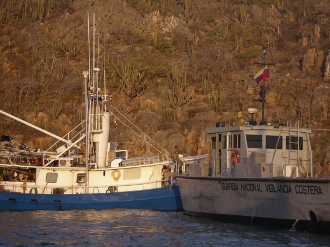 Shortly
thereafter we returned to Puerto La Cruz anchoring overnight in
Isla Coche. Alongside were Twilight, a converted fishing trawler,
US flag, and Andromeda, a Morgan Out Island, from Canada. We all
fished. The other boats caught ladyfish off the Araya peninsula.
The winds were piping which resulted in a rollicking, downwind
sail as we headed west into Chimana Segunda overnight. It was
sheer entertainment to see Twilight followed in by a huge coast
guard cutter. Willie and Mary noted that it is routine procedure
for them to be inspected and identified. The Ve government is
keeping close tabs on anyone that size. Graciously they shared
their fish and hosted our Valentine’s fish dinner.
Shortly
thereafter we returned to Puerto La Cruz anchoring overnight in
Isla Coche. Alongside were Twilight, a converted fishing trawler,
US flag, and Andromeda, a Morgan Out Island, from Canada. We all
fished. The other boats caught ladyfish off the Araya peninsula.
The winds were piping which resulted in a rollicking, downwind
sail as we headed west into Chimana Segunda overnight. It was
sheer entertainment to see Twilight followed in by a huge coast
guard cutter. Willie and Mary noted that it is routine procedure
for them to be inspected and identified. The Ve government is
keeping close tabs on anyone that size. Graciously they shared
their fish and hosted our Valentine’s fish dinner.
Early on February 15th 2006 we crossed to Puerto La Cruz and settled in for a couple of weeks enjoying dockside amenities and visiting friends. Below are some photos of the area around our marina Bahia Redonda in Puerto La Cruise
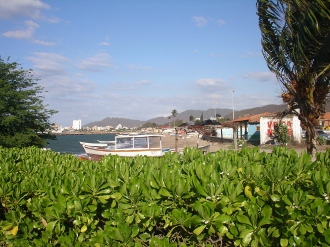
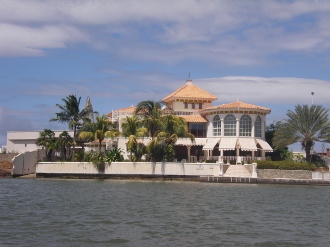
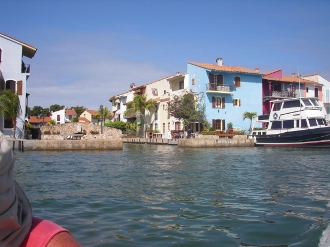
DEPARTURE
TO THE DUTCH ANTILLES ON Feb 28th 2006
On February 28th 2006, with fuel and provisions
topped up and Scrammin alongside, we said a bittersweet goodbye to
PLC. One short night in Isla Borracha
was enough. Being Carnival weekend it was crowded and our anchor
was a concern. It was a convenient stop en route to Isla La
Tortuga, but the williwaws blew off the cliffs all night long. As
well, a 0500 departure in darkness netted me a bat bite. It was
not my favorite spot
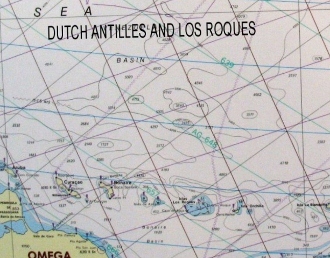
.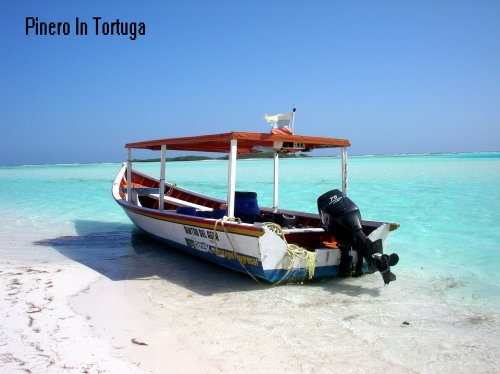
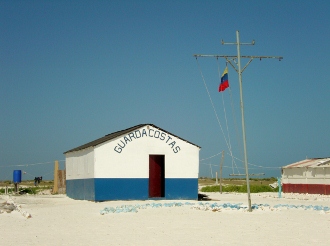
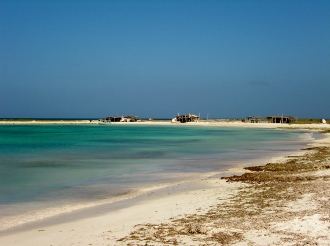 Playa Caldera
was our introduction to the out islands and reef country.
Navigation is a combination of GPS and eyeball sightings, watching
the latitude and longitude closely, and keeping a vigilant eye on
the depth sounder. We set anchor in lovely, clear blue water and
anchor-friendly depths of sand. The coastguard had a small hut
ashore and a frigate maintaining a presence here. It
returned several times in the 2 days we enjoyed there.
Playa Caldera
was our introduction to the out islands and reef country.
Navigation is a combination of GPS and eyeball sightings, watching
the latitude and longitude closely, and keeping a vigilant eye on
the depth sounder. We set anchor in lovely, clear blue water and
anchor-friendly depths of sand. The coastguard had a small hut
ashore and a frigate maintaining a presence here. It
returned several times in the 2 days we enjoyed there.
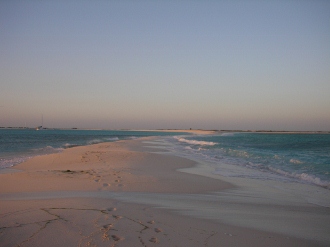
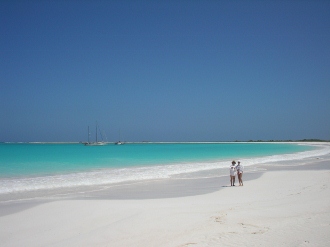 The second anchorage in Tortuga,
Cayo Herradura, is equally as beautiful and we yachties filled
this small piece of paradise. Fishermen had several shelters
ashore. A spectacular sand spit off of the main island separated
several reefs. Eighty-five miles to the northwest the low-lying
eastern Roques islands appeared quickly. The
first sighting is a huge wreck about half way up the outer reefs
and, yes, we appreciate GPS and other yachties advice. The
southern Sebastapol entrance is through two sets of reefs. Even at
0830 we could identify water colours and were very appreciative of
a secure anchorage to rest up and get our bearings. Several
yachties have been moving west with us. Straycat from Holland,
Wild Orchid from Britain, and Angel from Canada.
The second anchorage in Tortuga,
Cayo Herradura, is equally as beautiful and we yachties filled
this small piece of paradise. Fishermen had several shelters
ashore. A spectacular sand spit off of the main island separated
several reefs. Eighty-five miles to the northwest the low-lying
eastern Roques islands appeared quickly. The
first sighting is a huge wreck about half way up the outer reefs
and, yes, we appreciate GPS and other yachties advice. The
southern Sebastapol entrance is through two sets of reefs. Even at
0830 we could identify water colours and were very appreciative of
a secure anchorage to rest up and get our bearings. Several
yachties have been moving west with us. Straycat from Holland,
Wild Orchid from Britain, and Angel from Canada.
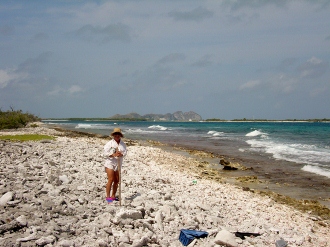 The Ve coastguard boarded 3
of us and required us to check into Gran Roque. We were registered
with the coastguard, the National Guard and the Roques imparque
and given a new zarpe with which to exit. The whole area is a
national park and very lovely. As we were in transit they required
us to move on within 5 days at no charge. All were very pleasant,
but the check ins were time consuming and riddled with paperwork.
Luckily our designated day in Gran Roque was provisioning day at
the market so fresh fruit and veggies were in abundance. One has
no idea how good ice cream tastes here! Our anchorages included
Buchyiaco at the entrance; Soyoqui, where one could see forever;
Nordisqui, just inside the NE outer reef. Here we had several
bonfires and great fun ashore with Scrammin‘. Franciquis was a
playground for the rich and famous. Hourly, pineros of tourists
would arrive for an afternoon on the beach. Umbrellas on an atoll
of sand with lunch and a snorkel were their expectation.
The Ve coastguard boarded 3
of us and required us to check into Gran Roque. We were registered
with the coastguard, the National Guard and the Roques imparque
and given a new zarpe with which to exit. The whole area is a
national park and very lovely. As we were in transit they required
us to move on within 5 days at no charge. All were very pleasant,
but the check ins were time consuming and riddled with paperwork.
Luckily our designated day in Gran Roque was provisioning day at
the market so fresh fruit and veggies were in abundance. One has
no idea how good ice cream tastes here! Our anchorages included
Buchyiaco at the entrance; Soyoqui, where one could see forever;
Nordisqui, just inside the NE outer reef. Here we had several
bonfires and great fun ashore with Scrammin‘. Franciquis was a
playground for the rich and famous. Hourly, pineros of tourists
would arrive for an afternoon on the beach. Umbrellas on an atoll
of sand with lunch and a snorkel were their expectation.
March 7th was Aleta’s 90th birthday and we celebrated it in
pristine fashion.
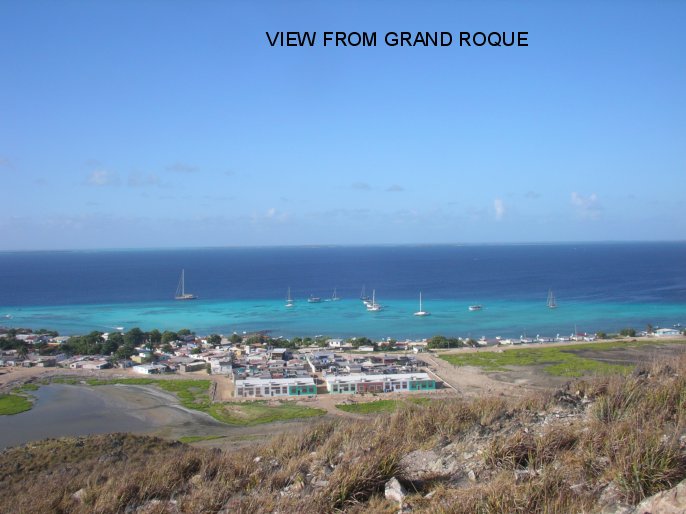
March 10th 2006 marked our exit
day from Gran Roque, so we dutifully returned to
have our zarpe signed out. From there we headed west via Islas
Noronsquis and Carenero and our time was up. Snorkeling and
swimming are luxurious in these islands. The fishes are mostly
protected and the largest of their species are in abundance.
Coincidentally, in Carenero, we met Bill Reid of Sarnia
origins. He’s enjoying his lagoon catamaran and was heading
for the mainland of Ve. On St Patrick’s Day, reluctant to
leave, we hauled anchor for Islas de Aves, the westernmost islands
of Venezuela. Aves de Barlovento ie windward is 37 miles
west and famous for it’s red footed booby bird. The mangrove atoll
is an aviary of booby birds, pelicans and frigate birds. What a
sight. The snorkeling was fabulous. We became waterlogged
exploring reef after reef. With good trade winds we stayed in the
shelter of the southern end. On the 20th of March we
reluctantly sailed 30 some miles to Sotavento Isla ie leeward. I
fish and fish and fish. Finally I catch a fish. Not one, but 3
barracuda! We decided to keep the one caught in deep water. It was
firm and delicious-similar to our northern bass in flavour.
Anchored securely behind Saki Saki island; minding our own
business; cleaning our barracuda; we hear a beep, beep, beep.
Lifting our sun shade who should appear, but the coast guard. Yes,
the coast guard! Three young men wanted to board. Because we were
rocking and rolling, it took myself and 2 of them to keep their
boat off Tundra. Yes we have our zarpe and we’re in transit. No
problema. Their open pinero looked in such bad repair that it may
sink any minute. Goodbye Venezuela!
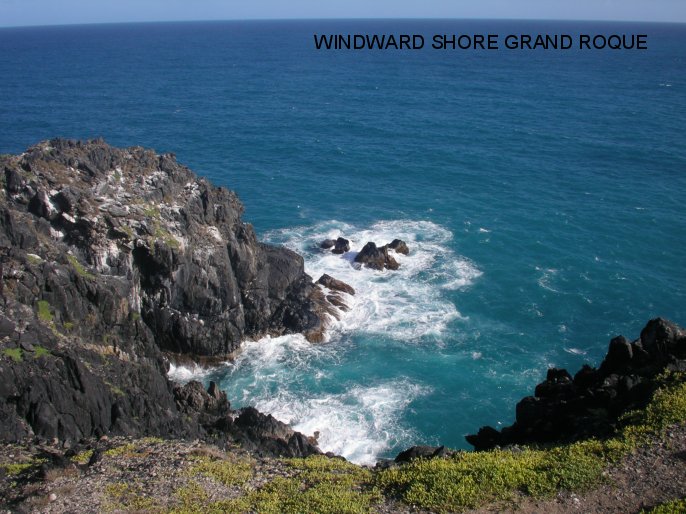
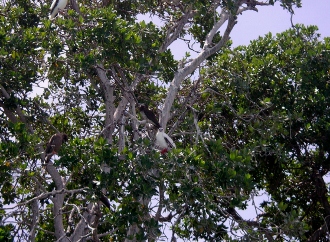
Again we were located in front of an aviary housing sooty terns, royal terns, laughing gulls and more. Being their mating season there were millions of them. We chose to walk on another little island just north and leave them in peace. Here we met Linda and Bob on Caravella and had a nice snorkel and bonfire with the group. Isla Palmeras was our last anchorage on Sotavento with wonderful snorkeling and a clear shot to Bonaire.
March 24th 2006 we said goodbye to Venezuela and now are sitting on a mooring buoy in Bonaire. It is slight culture shock to be in the middle of one of the premiere dive sites in the world. All ashore is commercialism and it will take us awhile to adjust back to` busyness’. Leaving the wonderful wildness of the Aves was a difficult task, but new adventures in another country were beaconing. A magnificent daybreak departure introduced our 48-mile downwind sail to Bonaire. Of course we fished and of course we made r/o water; the normal routines. Ghosting up the lee of Bonaire our first sightings were of the salt industry. Mountains of white salt ashore, and an ocean freighter loading, spoke of their thriving solar salt industry. Slaves were introduced to the island in the 17th century. Four people slept in their tiny slave huts after a days work in the blistering saline flats. Slavery was abolished in 1863. Bonaire, a Dutch possession, lies only 50 miles north of the Venezuelan coast, is 24 miles long and @ 5 miles wide. Klein (little) Bonaire is nestled off it’s west coast. The 13,000 inhabitants are a mixture of African, Spanish, Dutch and Portuguese Brazilian Jews. Today the tourist industry thrives on diving and snorkeling. A truck was the only way we could tour the rugged east coast and northern Washington Slagbaii national park. Bouncing along weathered volcanic ridges and miles of cactus skirted dirt tracks we viewed breathtaking vistas and original Amerindian encryptions. Salina ponds housed beautiful flamingo flocks while the towering cactus were home to small green parrots and geckos.
Our daily snorkeling sessions were rewarded with every fish in the
book-all sizes and colours. Coral was wonderful right underneath
our mooring. Large purple hornpipe coral stretched up at us.
Anchoring is not allowed in Bonaire as one may damage the coral.
The moorings were a bargain at $10.00 a day, although the welcome
ashore wasn’t overwhelming. There is only one dinghy dock to leave
the dinghy for any length of time and no showers available for
cruisers. We did appreciate garbage disposal sites.
April 1st we slipped the mooring for a gentle passage to Curacao.
A tour of Klein Curacao en route was enough. It
is a small atoll with a sandy beach and two mooring buoys for
tours out of Curacao proper. The swells nudged us on to the
comfortable protection of Spanish Waters in Curacao.
Checking into customs and immigration is quite the
procedure complete with anchoring permits for each anchorage one
intends to visit. A day’s job well done when complete! Spanish
Waters is about 5 miles from the capital of Willemstad,
which is configured in two areas. Punda (papiamento for point) is
the historic site and Otrabanda (the other side) are separated by
St Anna Baii, the entrance channel to Willemstad. Baroque and
Neoclassical architecture are outstanding on both sides of the bay
and restoration is very colourful. A Venezuelan floating market in
the central part of Punda is delightful.
A tour by car familiarized us with the bays and entrances on the
lee shore. The island population is 140,000. It is 37 miles long
and 9 miles wide at the widest part. The highest altitude is 1,800
feet precipitating an arid climate. As with the other Dutch
islands its inhabitants provide a mixed culture. The prominent
language is Papiamento. I can understand some of it with Spanish.
Dutch will definitely be a challenge!
A short cruise to St Martha bay was wonderful sailing west, but a
beat coming back. Here we sit until lay up time. So far we have
had a delightful snorkel in Caracasbaii, hiked to the fort here,
and toured the slave infirmary. Caves and a natural bridge on the
north of the island at Shete Boca National Park were rugged and
fascinating.
We are anchored just off Sarifundy’s Marine. They provide water,
food, happy hours and much more, but only have a dinghy dock, so
we are all at anchor. Sera Boca Marina is in another arm of the
bay of Spanish Waters and is booked solid in June of this year.
This may be an indication of many boats vacating Venezuela.
Andromeda has caught up with us and we all plan to haul at Curacao
Marine within the next few weeks. It is strictly a haul
out yard as well. Thinking of our work ahead we have spent several
days here touring the forts and snorkeling with Fia. Dave
and Judy are long time cruisers with lots of info for us.
Our haul date is April 26th and we fly home to
Sarnia on May 1st 2006.
TO CONTINUE WITH OUR TRAVELS ON OUR
RETURN GO TO THE PAGE ENTITLED DUTCH ANTILLES OR CLICK
HERE DUTCH ANTILLES
Page updated Feb 24 2018